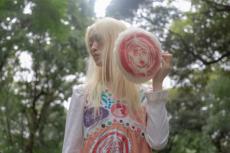「自分の作品を多くの人に見てもらい、メディアを超えたかったので、古着に絵を描いて友達にプレゼントして着てもらったのが始まりです」I & Fashion Issue : Alice Cline
NeoL / 2020年12月10日 17時0分
パンデミックで引き起こされた様々な変化を受けて、ファッションも転換期を迎えている。かねてより懸念されていた環境問題に関してのエシカルな動きは加速し、工業的な変化はもちろん、Black Lives Matterなどのムーヴメントからも文化の盗用やフィッシングをはじめとする問題にもさらに目が向けられるようになり、作り手のアイデンティティが強く問われる時代。そんな時代に、オリジナルを生み出すにはどのような思考、プロセスが必要なのか。New York University Gallatin School of Individualized Studyに在籍しながら、古着に独自のペインティングや装飾を施した服を披露、映像などヴィジュアルアートも手がけるAlice Clineに話を聞いた。(→ in English)
ーーまず自己紹介をお願いします。
Alice「私はAlice Cline。ニューヨークを拠点とするヴィジュアルアーティスト、デザイナー、フィルムメーカーです」
ーーファッションへの情熱はどのように生まれましたか。
Alice「アメリカのサウステキストで育ったのですが、私の家族はクリエイティヴィティとアートを愛する家族で、母は地元の美術館の登記係をしていました。そのために私はアートを身近にして育ち、創造的な目を養うことができたと思います」
ーー1日の始まりに服を選ぶときに、決め手となるのはどんなこと? 例えば天気、音楽、その日目に入った色など。
Alice「アパートの窓がニューヨークのイーストビレッジにある公園に面しているので、毎朝外を見て天気をチェックして、歩いている人たちの服装をチェックしています。天候に合わせた着こなしに加えて、色と質感をミックスしますね。最近は、ステートメントコートやユニークな靴を履いたカジュアルで快適なヴィンテージのメンズウェアを着るのが好き」
ーー特に好きな年代の服装はありますか。
Alice「自分の作品と日常のワードローブの両方で最もインスピレーションを得たのは1960年代と70年代。その時代のアート、映画、ファッションはとても革新的で、素晴らしい遊び心がありシックですよね」

ーー自分をどんな子どもだったと表現しますか。
Alice「ぼーっとした子どもでした。常に夢を見たり、絵を描いたり、物語を書いたりしていました。多くの子供たちと同じように、私は自分自身と自分のアートワークに色鮮やかな想像力と自信を持っていました。それ以来、私はそれを取り戻そうと努めてきたと思います」
ーー少女時代はあなたにとってどんな意味を持っていますか。
Alice「散らかったリップグロスとひざの擦り傷。少女時代は、友達と転げ回って笑ったり、外で遊んだり、母親の服を着たりしていました。ワイルドな気分で、同時に可愛くなりたいとも思っていました」
ーー制作に向かうインスピレーションの源は?
Alice「美術館とソーシャルメディアで見た他のアーティストからたくさんの刺激を受けています。最近はInstagramで見つけた @steakbagel と @johnyuyi の作品にとても興味があります。映画を観たり、オンラインでアートを見たりして寝る前の夕方、意識がなくて眠っているときが一番クリエイティヴだと感じます」

ーーファッションで自己表現をする際の自分の中の哲学があれば教えてください。
Alice「サステイナビリティとその影響を受けた芸術にモチベーションを感じます。私の作品は通常、自分が繋がっていると感じるものや人を描いたパッチを使って装飾または再加工したヴィンテージテキスタイルです」
ーーファッションにはどんなパワーがあると思いますか。
Alice「ファッションは自己表現の方法としてはとても強力なもの。私たちはそれを毎日、おそらく他のどの形式の芸術よりも多く目にしています。服は物語を共有し、他の人を刺激することができますが、その社会の変化と進歩に関連する側面はしばしば忘れられがちですよね」
ーーファッションは外見の意識だけでなく、政治的スタンスを表す道具でもあります。BLMなどの政治的ムーブメントはどのようにこれからのファッションを変えてゆくと思いますか。
Alice「すでに変えていっています。Black Lives Matterは、人々に自分が何を着ているのか、自分の選択や特権が他の人にどのように影響するのかを真剣に考えるきっかけになりました。黒人のアーティストやデザイナーにスポットを当てて祝福することでファッションの制度を変えるだけでなく、ファッション業界を悩ませている表現や差別の問題の多くを断固として拒否し、変えていくでしょう」
ーー自分の”raceがどのようにファッションの世界で表現されてると感じますか。
Alice「ええ、私は白人でアメリカ人なので、自分の人種がファッションの世界で過大評価されていると感じます!」
ーーあなたのアイデンティが自分の作品に反映することはありますか?そのアイデンティーで限界を感じることはありますか。
Alice「間違いなく反映されています。自分の作品のすべてにおいて、アイデンティティを視覚的に明らかにしようとしているんです。しかし、時々、完成した作品を見て、自分自身が出ているとは思わない場合もあります。また、私は白人でアメリカ人なので、オーセンティックで文化的に多様な方法で創造する能力は限られており、発達の途中だとさえ思います。これを解決するために見つけた唯一の方法は、自分とは異なるバックグラウンドを持つ他のアーティストやデザイナーに触発され、コラボレーションすることなのです」

ーーあなたの作品はたくさんの色があって手描きのものが多いですが、どのようにしてそのスタイルにたどり着いたんですか。
Alice「服のデザインを始める前はヴィジュアルアーティストであり、中でもペイントを主としていました。でも、一度インスタグラムに投稿したら後はポートフォリオにしまわれっぱなしで二度と人目に触れないような絵を描いているような気がしていたんです。自分の作品を多くの人に見てもらい、メディアを超えてもらいたかったので、古着に絵を描いて友達にプレゼントして着てもらいました。時が経つにつれて、作品にはアップリケ、装飾、ボタンが含まれ始め、色と遊びが増えてきました。よく着て見てもらいたいというモチベーションから制作が始まったのに、作品がとても繊細で細かく、丁寧に作られているため短期間しか着られないのは、ちょっとファニーで、アイロニーのようですよね」
ーーあなたのテキスタイルが好きです。あなたにとってテキスタイルとは?
Alice「私は主にヴィンテージまたは再利用されたテキスタイルを作品に使用しています。私にとってテキスタイルは作品のベース。その上で作品が構築される基盤であるため、まとまりがあり、練られたものでなければなりません」
ーーパンデミックによって、ファッションのプレゼンテーションも変わってきています。自分のファッション、またクリエイションそれぞれに変化はありますか。
Alice「自粛中は家族と一緒にテキサスの家にいたので、ニューヨークに引っ越して以来久しぶりに戻った家とそこでの文化にたくさんの刺激を受けました。写真家の友達にセルフポートレイト、または距離を表現するような写真を撮ってもらって作品を制作しました。また、その期間中に人気があったFaceTimeの写真撮影も非常に興味深いと思います」
ーーファッションにおける環境問題、政治との関係をどう捉えていますか。
Alice「古着やテキスタイルを再利用して、そうしたものたちに第二の用途を提供しています。ファッションは新しさと消費主義に非常に重点を置くことで、気候変動に大きく関係してきました。私たちが消費量を減らしても大きな変化や世界的な変化をもたらさないかもしれないけど、誰もが地球に与える影響を配慮する必要があるはず。何を購入し、誰をサポートするかを考えることで、ファッション業界はよりサステイナブルな部分に価値を置くようにシフトします。自分の作品でもそうした方向を推進したいので、自分のメソッドとマテリアルで表現しようとしています」

ーーパンデミックでクリエイティヴになりづらいと感じている人もいますが、どのようにインスピレーションを得ていますか。
Alice「本当に大変でしたね。家族と自粛中は、勢いを保つのに本当に苦労したし、80年代の名作映画やテレビ番組を見ているだけで何日も過ごしていました。今はニューヨークに戻って、ミュージシャンである親友のキールスト( @chowkiersten )と一緒に住んでいますが、彼女はいつも音楽を演奏したりジャーナルをやっていて、彼女が紡ぎ出すクリエイティヴなエネルギーによって私も創造的になれるんです。ニューヨークに戻ったことでインスピレーションを得ることができているように思います。切迫感のようなものがあって、それが大切なんだなと改めて感じました」
ーーオンラインでたくさんの情報に触れてしまう中でオリジナルをどのように作りますか。また自分の中で、アイデンティティを確立できたと思う瞬間、または殻/壁を破れたという瞬間があったとしたらどのような時?
Alice「意図せずに他の人の作品を真似していたり、作成したものが以前どこかで見たことがあることに気づいたりするという心配は常にあります。インターネット上ではイメージが山ほど溢れていて、自分の想像力というものがよくわからないような状態になることもあります。いいねやフォロワーに煩わされないようにしたいと思うけど、現在の業界では、大きなプラットフォームがないということは誰にも見られないアートを作っているという風に感じることがあるのも事実。何ヶ月もかけてインスタグラムに投稿されるだけの何かを作っているような気がします。アートには観客が必要であり、見てくれる人にアクセスする方法がないように感じてイライラすることがあります」
ーー自分で殻を破ったと思ったのはどういう時?
Alice「セルフポートレイトに挑戦するとき、当たり前だけど自分が自分のアイデンティティを最もよく知っているんだと実感しました。最近、私は自分自身についての物語のようなエッセイを基にした短編映画に取り組んでいて、自分のイメージに沿ってカメラの前で踊ったり操れたりするマリオネットを作ったんです。他の人が消化できるようなやり方で私のアイデンティティを視覚化して再構築するのは本当に奇妙な感じでしたね。あとは他のアーティストとコラボレーションしたり、愛する人たちのための作品を作ったりすることで、殻から抜け出した気がします」
ーーあなたは映画も大好きですよね。どうしてそんなに夢中なのか教えてください。そして好きなクリエイターもお願いします。
Alice「常に映画に夢中だったのですが、おかしなことに、フィルムメーカーになりたいと思ったのはティム・バートンの『チャーリーとチョコレート工場』がきっかけです。子どもの頃に夢中になって、全く違う世界を画面上に作るという映画に魅了されたし、自分にもそれができると考えるとさらにエキサイティングでした。大人になって、主に60年代と70年代のハリウッド黄金期と、Wes Anderson、Taika Waititi、Richard Ayoadeなどの現代の新しい才能ある監督たちの影響を受けています。素晴らしい映画を見た後、劇場を出て『ああ、本当にああいうことがやりたい』と感じる時が一番好きです」
ーーファッションと映画は互いに影響を与え合っていますが、あなたが作りたいのはどのような映画ですか。
Alice「ファッションと衣装は自己表現の核であり、キャラクターが映画の中でどんな人物なのかについて多くのことを伝えることができます。この部分を強調した映画を作り、ファッションによってシンボリズムとトーンが語られるような作品を作りたいです」
ーーパンデミックや環境汚染でファッション業界も変わってきていますが、どのようにご覧になっていますか。
Alice「パンデミックは、シーズンごとの消費主義と狭いマージンへの依存の中にある、ファッション業界の多くの欠陥を赤裸々に晒しました。この特性、およびファストファッションや大量生産は、気候変動を悪化させています。古着やデザインされて長持ちする服を持つようになることで、そのファッションが問題の一部ではなく、変化のきっかけになることを願っています」
ーーファッション学生が今やるべきことは?
Alice「確信的なことを言うのは難しいですね。今年卒業するので、アートの研鑽を続けるだけでなく、ニューヨークで自分をサポートする方法を模索するつもりです。多くの雑誌や制作会社がパンデミックで休業したり廃業しているので、今すぐ自分の道を見つけようとするのは本当に大変。私はできることをすることに集中し、インスピレーションを維持しようとしています」
ーーファッションでの表現にしても、自分の殻を破るということにしても、アクションを起こしたい、一歩踏み出したい人のために何かアドバイスは?
Alice「正直なところ、私はまだ時々自分が快適だと思えるゾーンから出れていません。私のアドバイスとしては、境界線に挑戦しているあなたが好きなアーティストを研究すること。私は常にDavid Byrne、David Lynch、Andy Warholに触発され、彼らのアイデアを現代的な設定に変換する方法を考えています。自分がどんな人間であるかを表現する芸術のパートを見つけて、別の分野にも応用する方法を考えてください。私はまた、学際的なアートをとても支持しています。多くの場合、アーティストやデザイナーはやり方が王道すぎると思うんです。媒体を変更すると、最終的にお気に入りの表現方法に戻ったとしても、作品の強化と進化に役立つ力や表現が得られると思います」
Alice Cline
https://alicecline.com
https://www.instagram.com/alicelcline/
text & edit Ryoko Kuwahara

-Can you introduce yourself?
Alice : My name is Alice Cline, and I am a visual artist, designer and filmmaker based in New York City.
-What are the roots to your passion?
Alice : I grew up in South Texas in the US, in a family that really celebrated creativity and art. My Mother was a registrar at a local museum, and that allowed me to be around art and develop a creative eye at a young age.
-What does your outfit everyday depend on? Is it affected by the weather, colors that catch your eye?
Alice : My apartment windows face a park in New York’s East Village, and every morning I look outside to check the weather and see how other pedestrians are dressed. I try to mix color and textures in addition to dressing for the weather, lately I’ve been really into wearing casual and comfortable vintage menswear with a statement coat or unique shoes.
-What period fashion do you like and why do you like it.
Alice : My favorite era that I derive the most inspiration from, in both my work and my daily wardrobe, its the 1960’s and 70’s. The art, film and fashion from that era was so innovative and so playful and chic.

-How would you describe yourself as a child?
Alice : I was a space cadet. I was constantly day dreaming and painting and writing stories. I, like many children, had a vivid imagination and a lot of confidence in my self and my artwork, and I think I’ve been trying to recapture that ever since.
- What does girlhood mean to you?
Alice : Messy lipgloss and scraped knees. Girlhood is scream laughing with your friends, and playing outside, and dressing up in your mother’s clothes. I think girlhood is feeling wild and wanting to be pretty at the same time.
-What is your main source of inspiration?
Alice : I’m really inspired by other artists, in both museums and on social media. Lately I’ve really been interested in the work of @steakbagel and @johnyuyi on instagram. I feel most creative in the evening time after watching a film or looking at art online before I go to bed, when I’m halfway unconscious/asleep is when I get my best ideas.

-When you express yourself in fashion, do you have your own philosophy?
Alice : In fashion I’m motivated by sustainability and that art of influence. My work is usually embellishment or reworked vintage textiles with painted patches that depict objects and people I feel connected to.
-What power do you think fashion has?
Alice : I think fashion is so powerful as a method of self expression. We see it everyday, maybe more than any other form of art. Clothing can share stories and inspire others, and is a crucial but often forgotten aspect of social change and progress.
-Fashion is not just about appearance; it is also a tool for political statements. How do you think the Black Lives Matter movement will change fashion?
Alice : I think it already has. BLM has really made people think about what they’re wearing and how their choices and privilege affects others. I’m think that Black Lives Matter will not only change the institution of fashion by highlighting and celebrating Black artists and designers, but also reject and change a lot of the issues of representation and discrimination that plague that fashion industry.
-How do you feel your ‘race’ is represented in the fashion world?
Alice : Yes. I’m white and American, so my race has actually been overrepresented in the fashion world.
-How do you feel that your identity plays a role in making art? Do you feel that it occasionally limits you?
Alice : Absolutely. In all of my work, I am trying to reveal parts of who I am visually. However sometimes I’ll finish a piece and look at it and not recognize myself. I also think because I am white and American, my capability to create in a way that is authentic and culturally diverse is limited, even stunted. The only way I’ve found to resolve this is to be inspired by and collaborate with other artists and designers that have different background than my own.

- Your style tends to use many colors and hand-drawn, how did you come to make this kind of art?
Alice : Before I started designing clothing I was only a visual artist, and primarily a painter. But, I felt like I was making paintings to just post on instagram once and then live in my portfolio forever, never to be seen again. I wanted my artwork to be seen by lots of people and transcend medium, so I started painting vintage clothes and gifting them to my friends to wear. Overtime my work began to include appliqué and embellishments and buttons, with lots of color and campiness. I think it's sort of funny, or maybe ironic, that my work began with the motivation to be worn and seen often, and now the pieces are so delicate and detailed that they can really only be worn very carefully and short periods.
-I love your textiles. What textiles is to you?
Alice : I use mainly vintage or repurposed textiles in my work. To me, textiles are the base of a piece. They are the foundation to be manipulated and built on top of, and they should be cohesive and thoughtful.
-Due to the pandemic, the way fashion is presented is very different. What are ways you continue to make work that is original?
Alice : I was at home staying with my family in Texas during quarantine so I was really inspired by my childhood home and the culture there that I haven’t really experienced since I moved to NYC. I worked on pieces that I mailed to my photographer friends to be shot as a self portrait or at a distance. I also think the FaceTime photoshoots that got really popular during quarantine are really interesting as well.
-How do you communicate your views on climate change and politics through fashion? and how do you maintain your originality through that.
Alice : I reuse and repurpose vintage fabrics and textiles to give them a second life. Fashion is a huge contributor to climate change, the industry is hyper-focused on newness and consumerism. Thrifting and reducing the amount we consume might not make a huge or worldwide change, but I think that everyone should be considerate about the impact they have on others and our earth. By being thoughtful about what we buy and who we support, it shifts the focus of the fashion industry towards more sustainable values. I want to encourage this in my work, so I try to express it in my methods and materials.

-With quarantine and staying at home, many find it harder to be creative. What are ways you get inspiration?
Alice : I’ll be honest, it’s been really hard. When I was quarantining with my family I was really struggling to maintain my momentum, and spent a lot of days just watching classic movies and television shows from the 80’s. But now I’m back in New York, and I live with my good friend Kierst (@chowkiersten) who is a musician. She’s always playing music or journalling, and the creative energy she puts out really helps me be creative as well. Being back in New York in general helps me get inspired, there’s a sense of urgency here that I missed.
-In a time where you have access to millions of works online, how do you maintain original work? Are you affected by likes and followers on social media?
Alice : I do worry sometimes about ripping off other people work unintentionally, or creating something and realizing that I’ve seen it somewhere else before. On the internet we are constantly bombarded with images, and it can sometimes make me feel alienated from my own imagination. I wish I wasn’t bothered by likes or followers, but in the current industry if you don’t have a large platform, it can feel like you’re making art for no one to ever see. I often feel like I spend months creating something for it to only end up posted on instagram. Art needs an audience, and it can be frustrating to feel like there’s no way to access one.
-When are moments that you discover your identity. When is the time you feel that you break out of your own identity?
Alice : I am most aware my identity when I venture into self portraiture. Recently I was working on a short film with a narrative essay about myself, and I made a marionette in my image to dance and manipulate on camera. It was really strange to be visualizing and reinterpreting my identity in a way that others could digest. I feel like I break out of this when I collaborate with other artists, or create things to honor the people that I love.
-Were you always into the movie? What was the movie you discover for the first time yourself? Who was the artist you got actually into?
Alice : I was always into movies, and funnily enough, it was Tim Burton’s Charlie and the Chocolate Factory that made me want to be a filmmaker. As a child I was so fascinated by it, and the way that entire other worlds can be created on screen. The idea that I could do that was even more exciting. As an adult I’m primarily influenced by the Hollywood Renaissance in the 60’s and 70’s and contemporary coming of age directors like Wes Anderson, Taika Waititi, and Richard Ayoade. My favorite feeling is when I leave a theatre after watching a great movie and think, “wow I really want to do that."
-Fashion and the film influence each other. What the film will you plan to make ?
Alice : Fashion and clothing are central to self expression, and they can communicate so much about a character and who they are in a film. I want to make films that highlight this, and use fashion as a source of symbolism and tone.
-The pandemic and climate change has shaped fashion in a certain way. What is your opinion on this?
Alice : The pandemic really exposed a lot of flaws in the fashion industry, within it’s reliance on seasonal consumerism and narrow margins. This trait, and fast fashion/mass production, has really exacerbated climate change. I’m hoping that as we turn towards owning clothing that is either secondhand or designed and made to last, that fashion will be more of a catalyst for change instead of a part of the the problem.
-Currently, fashion is experiencing a big transition. As a fashion student in this era, what are your next steps?
Alice : It’s difficult for sure. I’m graduating this year so I’m planning to continue my artistic practice but also try to find a way to support myself in New York. So many magazines and production companies are closing or going out of business after the pandemic, its really daunting to try and find your way right now. I’m focusing on doing what I can, and trying to stay inspired.
-What is your advice to someone who is trying to step out of their comfort zone in fashion, to test their limits and take action.
Alice : Honestly, I still struggle with stepping out of my comfort zone sometimes. My best advice is to study artists that you love that have challenged boundaries, for me I’m constantly inspired by David Byrne, David Lynch, and Andy Warhol, and think of how their ideas can be translated to a contemporary setting. Find the parts of your art that express who you are, and think of a way to apply them in other ways. I’m also a huge advocate for interdisciplinary art. Often artists and designers are too loyal to a style of creating. Changing mediums, even if you ultimately return to your favorite, really helps enhance and evolve your work.
Alice Cline
https://alicecline.com
https://www.instagram.com/alicelcline/
text & edit Ryoko Kuwahara
関連記事のまとめはこちら
https://www.neol.jp/fashion/
外部リンク
- 「自分の作品を多くの人に見てもらい、メディアを超えたかったので、古着に絵を描いて友達にプレゼントして着てもらったのが始まりです」I & Fashion Issue : Alice Cline
- RIMOWA 現代におけるモビリティの再解釈として 「NEVER STILL」ソフトバッグコレクションを発表
- 「再生可能な素材の服を集めたセレクトショップをやりたい。アートを作ってる人みんなで集まって一緒に新しい文化を作りたい」I & Fashion Issue : Rou
- 「田舎で育ったので、猪などの動物の毛の感じや鳥、虫などがヘアのシルエットを作る時に自然と出てくる」I & Fashion Issue : Hayate Maeda
- 「サステイナブルでありながらもラグジュアリーでモダンなファッションにできるということを見せたい」I & Fashion Issue : Chantelle Thach
この記事に関連するニュース
-
この英語ってどんな意味?「Wake up and smell the coffee.」
OTONA SALONE / 2025年1月4日 7時0分
-
英語での会議や会話で自分の意見を述べたいときは?“I think~”以外の使える表現のバリエーション【ビジネス英会話のコツ】
THE GOLD ONLINE(ゴールドオンライン) / 2025年1月2日 9時15分
-
tHE GALLERY HARAJUKUにて、2025年1月2日(木)より、THEKLA KAISCHAURI個展「FRACTURED」を開催。
PR TIMES / 2024年12月25日 14時45分
-
Shareholder Proposals to Japan Business Systems, Inc.
PR TIMES / 2024年12月22日 14時40分
-
この英語ってどんな意味?「apple of my eye」
OTONA SALONE / 2024年12月22日 7時0分
ランキング
-
1天正遣欧使節・千々石ミゲルの墓、長崎県諫早市の文化財に…ミカン畑での墓石発見から20年
読売新聞 / 2025年1月15日 17時0分
-
2高齢者は「体重」が重要…標準を下回ると死亡リスクが急上昇
日刊ゲンダイDIGITAL / 2025年1月15日 9時26分
-
3芸能人なぜ呼び捨て?「日本語呼び方ルール」の謎 日鉄会長の「バイデン呼び」は実際に失礼なのか
東洋経済オンライン / 2025年1月15日 9時20分
-
4スニーカーのインソールを変えるだけで「靴の機能は劇的にアップ」する。“初心者が買うべき”一足とは
日刊SPA! / 2025年1月15日 15時51分
-
5「室内寒暖差がつらい…」その要因と対策が明らかに! - 三菱電機が紹介
マイナビニュース / 2025年1月14日 16時10分
記事ミッション中・・・
記事にリアクションする
![]()
記事ミッション中・・・
記事にリアクションする

エラーが発生しました
ページを再読み込みして
ください










